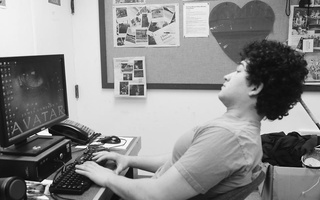The obvious risk in recreating a play that has already been performed many thousands of times is unoriginality. Evidently, this is a risk of which most Shakespeare directors are terribly afraid: it seems each stage production of one of his plays, and even more so each film, must be set in an era never before attempted, cast in an atypical fashion, and utilize domineeringly unpredictable visuals. And indeed, Joss Whedon’s adaptation of “Much Ado About Nothing” seems to continue the pattern based on its poster, which inexplicably features an almost entirely black-and-white image of the character Claudio snorkeling in a lake and holding some red mixed drink. Hardly traditional Shakespeare.
Yet what Whedon has done in adapting one of Shakespeare’s most well-known comedies is far more revolutionary than what any technological innovation or skilled costume designer could provide. He steps back almost completely as a director, so much so that one occasionally falls under the illusion of watching a stage production due to the remarkably understated visuals. The choice to film entirely in black and white is an unmitigated success—the grayscale is not some pretentious trick, but in fact an intelligent and efficient way of pulling all but the source text into the film’s background. Throughout the movie, Shakespeare’s words shine above all else, and it is thus unsurprising that the film succeeds most during moments in which the comedy is entirely textual: Benedick and Beatrice’s cleverly crafted banter, for example, or Dogberry’s complete miscomprehension of the English language.
Of course, Whedon’s film is not a stage production, and this leaves the more plot-driven scenes feeling rather dull. The scheming of Don John and Conrade (a feminization of Conrad, who is male in the original play) remains fairly boring despite Whedon’s rather unimaginative attempt to add interest by inserting a sexual relationship between the pair. On stage, even these less interesting scenes would remain engaging, simply because live theater has a force and energy that cannot be replicated on a screen.
Though Whedon’s simplification approach is thus at times overly stark, it does far more good than bad—not simply for the film itself, but one hopes, for Shakespeare adaptation as a whole. Yes, stunning visuals and bizarre transformations of time and place can work in reconfigurations of Shakespeare plays and may even be themselves important creative strides. But only a film like Whedon’s, one that holds the play’s text in a position of absolute primacy, demonstrates an understanding of why we bother to adapt Shakespeare in the first place.
—Staff writer Grace E. Huckins can be reached at gracehuckins@college.harvard.edu.
Read more in Arts
Summer At The MoviesRecommended Articles
-
The Merchantess of VeniceHarvard’s Athena Theater Company will diverge from one theatrical precedent to reclaim another when it performs Shakespeare’s The Merchant of
-
SPOTLIGHT: Robert D. Salas '08 & Winter Mead III '08The partnership of Robert D. Salas ’08 and Winter Mead III ’08 is mostly a testament to the luck of
-
All Ends Well in ‘Tragedee’Shakespeare’s “Romeo and Juliet” has inspired an abundance of adaptations, from Sergei Prokofiev’s ballet to Leonard Bernstein’s “West Side Story.”
-
 The Limits of Perception
The Limits of Perception -
 Top 10 Films of 2016
Top 10 Films of 2016














